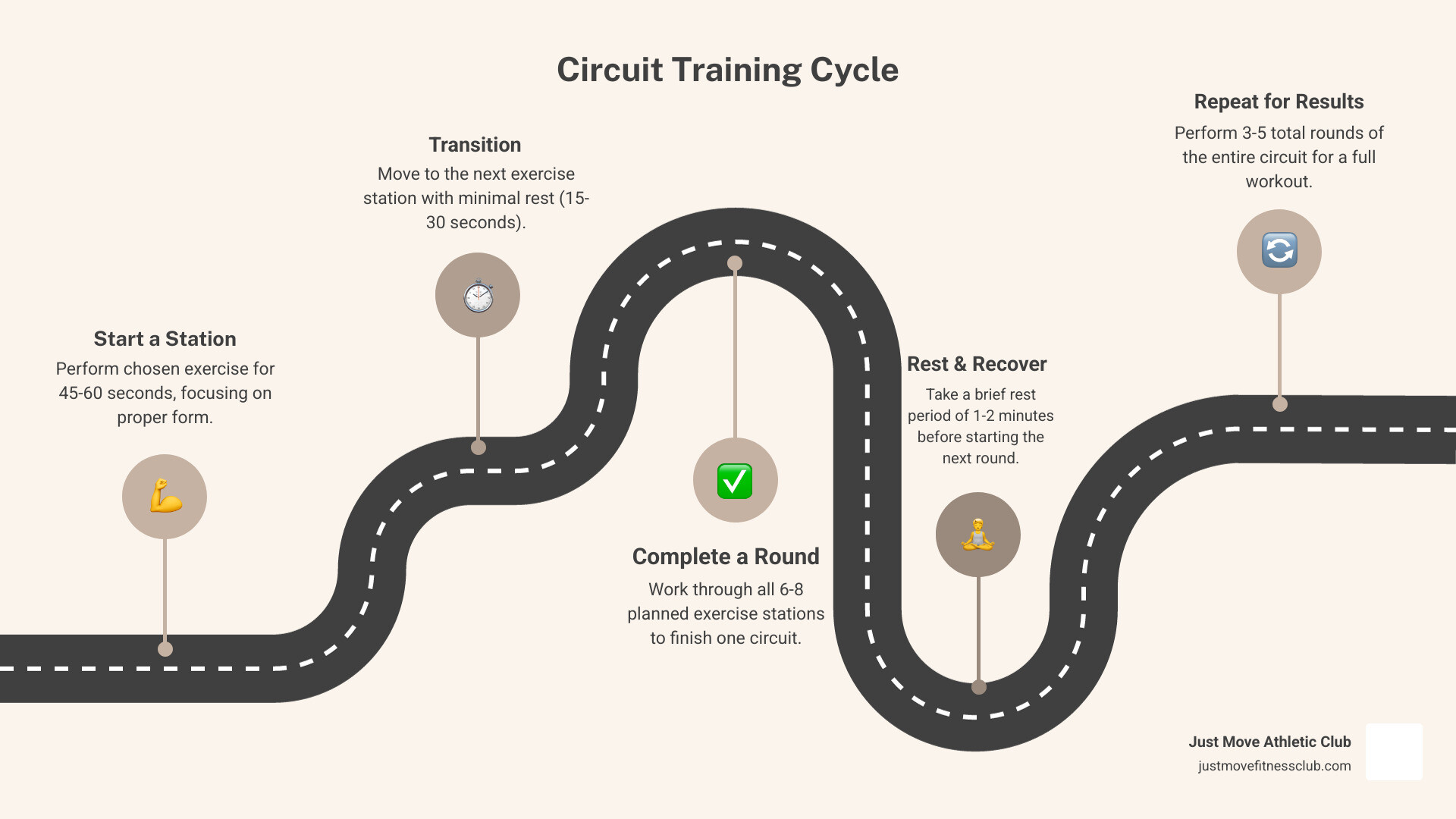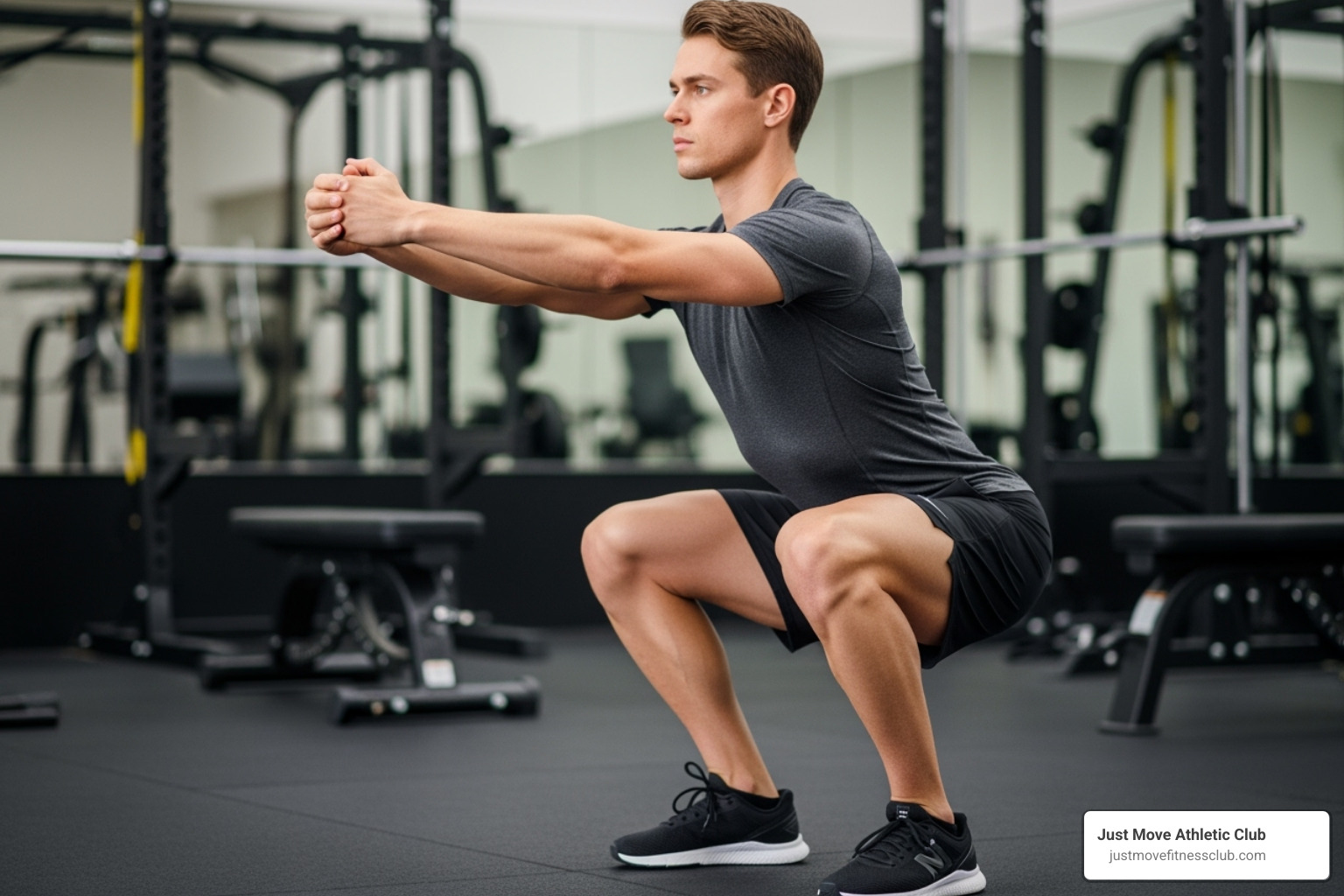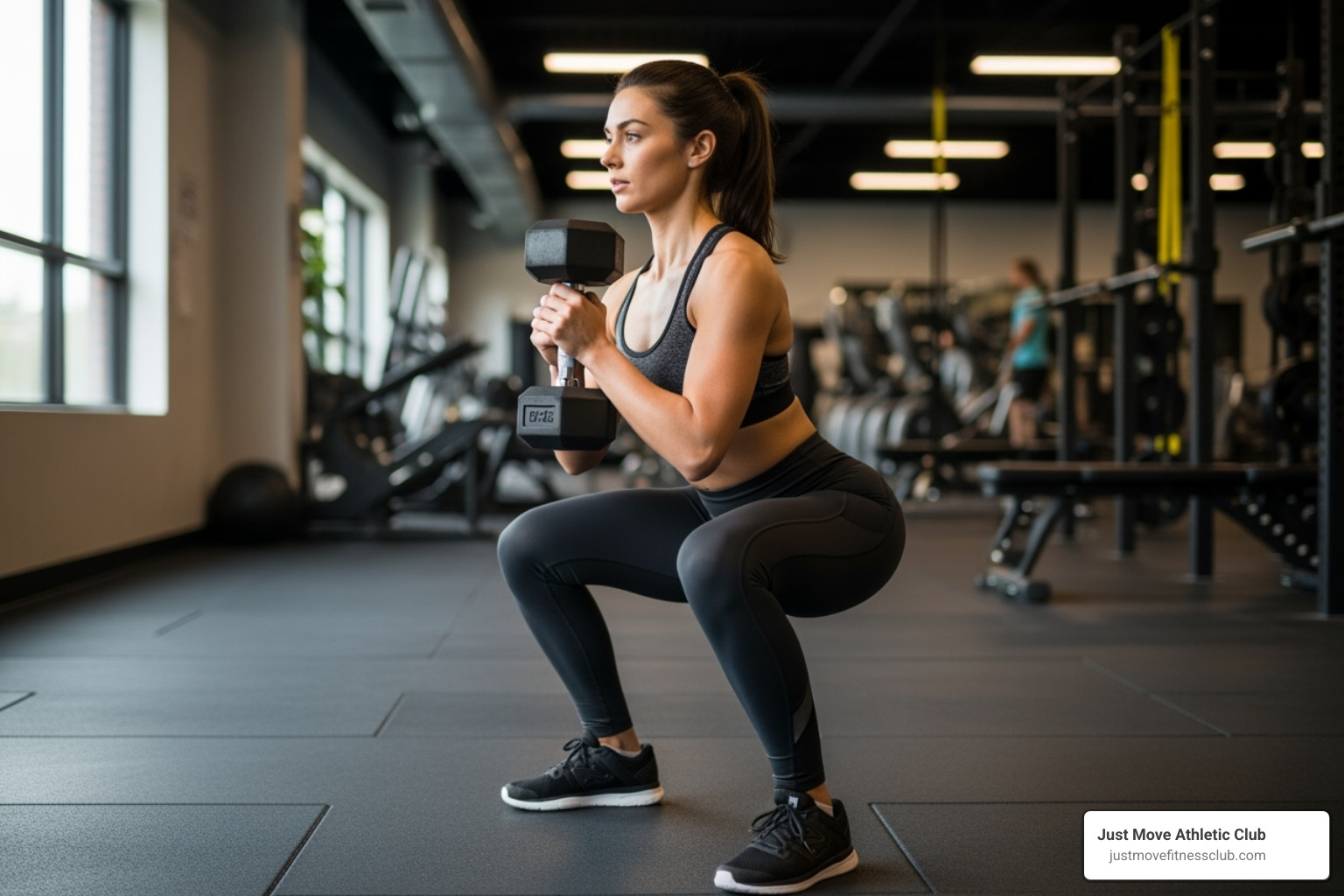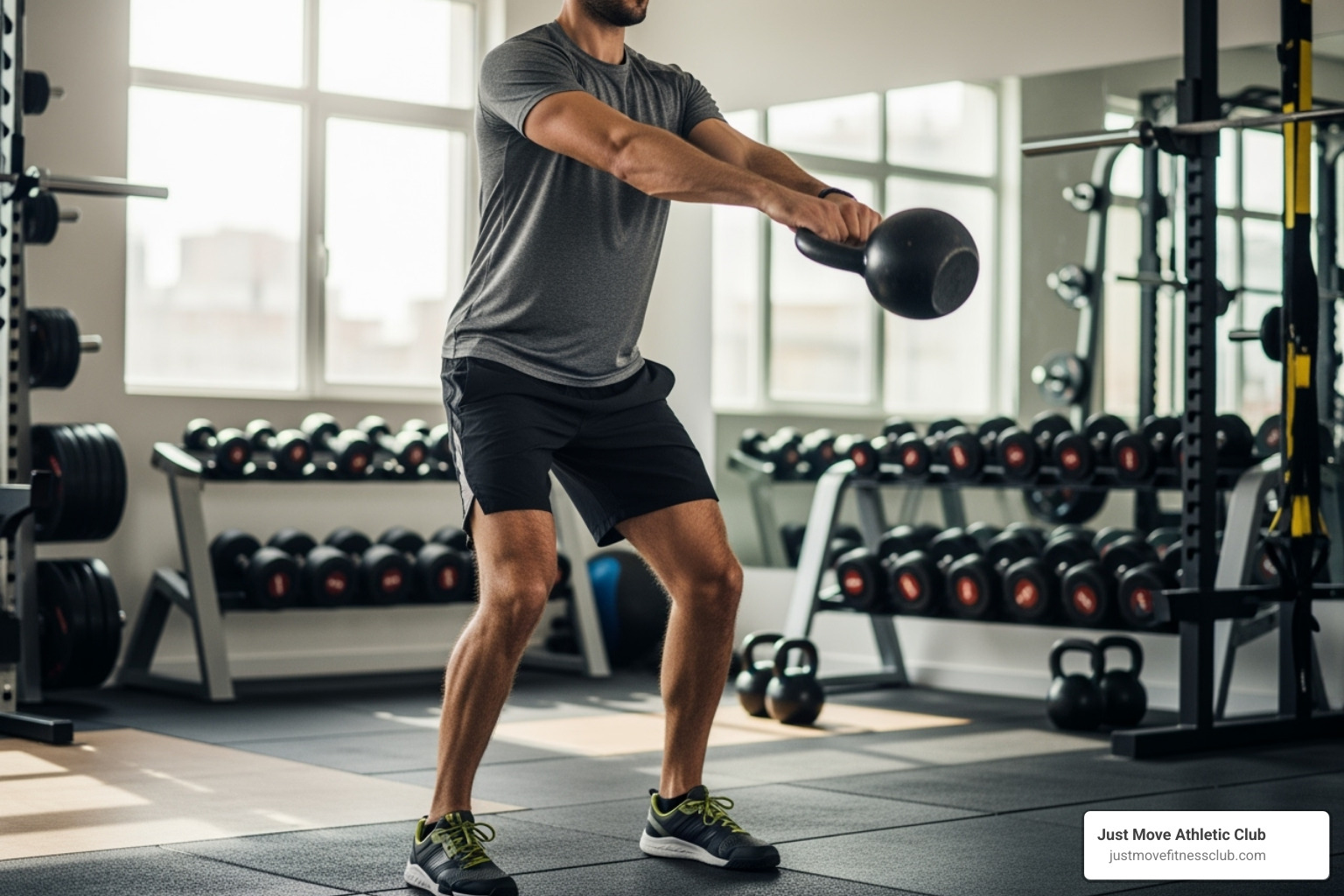Why Circuit Training is Your Weight Loss Game-Changer
A workout circuit for weight loss combines strength and cardio exercises performed back-to-back with minimal rest, creating an efficient fat-burning session that can be completed in 20-30 minutes.
Key benefits of circuit training for weight loss:
- Burns 300-500+ calories in a single 30-minute session
- Boosts metabolism for hours after your workout (EPOC effect)
- Builds lean muscle while burning fat simultaneously
- Saves time – get both cardio and strength training done together
- Prevents boredom – constantly changing exercises keep workouts fresh
- Adaptable – works for beginners to advanced fitness levels
Think of circuit training as the Swiss Army knife of workouts. You’re hitting multiple fitness goals at once, and research shows combining strength training with cardio is more effective for building strength and burning fat than cardio alone.
The structure is key: you move from one exercise to the next with minimal rest, keeping your heart rate liftd. This maximizes calorie burn during your workout and triggers the “afterburn effect,” where your body continues burning extra calories for hours.
I’m Pleasant Lewis, founder of Just Move Athletic Clubs with over 40 years in the fitness industry. Throughout my career, I’ve seen countless members achieve remarkable weight loss results using workout circuit for weight loss programs that combine fun, efficiency, and real results.

Why Circuit Training is a Weight Loss Powerhouse
Unlike fitness trends, workout circuits for weight loss are backed by solid science and deliver results that make long hours on a treadmill a thing of the past.
Your Metabolism Gets a Serious Upgrade
Combining strength training with cardio in a circuit turns your body into a 24/7 calorie-burning machine. This matters because muscle tissue burns more calories at rest than fat tissue. Building lean muscle through circuit training upgrades your body’s engine, burning more calories even while you rest. Strength training creates a long-term metabolic boost, while cardio intervals provide an immediate spike. It’s the best of both worlds in one workout.
Calorie Burn That Actually Makes a Difference
Unlike traditional workouts with long rests, circuit training keeps you moving from one exercise to the next. This keeps your heart rate liftd throughout the entire session. This sustained effort maintains a calorie-torching intensity for 20-30 minutes. Working multiple muscle groups demands more energy, resulting in a higher total calorie burn.
The Afterburn Effect is Real (And Awesome)
A major benefit is the afterburn effect, or EPOC (Excess Post-exercise Oxygen Consumption). Your body continues to burn extra calories for up to 24-48 hours post-workout. This happens as your body uses energy to repair muscle tissue and replenish energy stores. This recovery work requires calories, meaning you’re still burning fat long after you’ve finished exercising.
Building Lean Muscle While Burning Fat
Compared to cardio-only workouts, circuit training shines by building lean muscle and burning fat simultaneously. This creates the toned, defined look many people desire. The muscle-building aspect is crucial for sustainable weight loss, as more muscle means a higher resting metabolic rate. A 2021 study shows circuit training reduces fat mass and increases muscle mass while improving strength and cardiovascular fitness. This improves your body composition, not just the number on the scale. Your clothes will fit better, which is a truer sign of progress.
Your Heart Gets Stronger Too
Circuit training is also about health. Keeping your heart rate liftd gives your cardiovascular system a fantastic workout. This improved cardiovascular health means better stamina, more energy, and a stronger heart. For insights on balancing exercise types, check out our guide on Cardio, Weights, or Both? How to Mix Your Workouts for Results.
Time Efficiency That Actually Works
Most of us are busy. Circuit training fits real life by providing a complete full-body workout in just 20-30 minutes. You get both strength and cardio benefits in one session, making it easier to stay consistent. Research consistently shows that combining strength and cardio is more effective for fat loss than either alone. Circuit training offers this powerful combination efficiently.
The Ultimate Workout Circuit for Weight Loss: 3 Levels of Burn
Ready to start? Here are three progressive workout circuit for weight loss routines for every fitness level. Start where you feel comfortable, master the movements, and level up when you’re ready. Each circuit is designed to maximize fat burn and build lean muscle for sustainable weight loss.
Beginner Bodyweight Blast (At-Home Friendly)

New to exercise or prefer working out at home? This bodyweight circuit is the perfect starting point. No equipment needed. Focus on mastering proper form to build foundational strength.
For this circuit, perform each exercise for 30-45 seconds, rest for 15-20 seconds, then move to the next exercise. Complete 2-3 rounds with 60-90 seconds of rest between rounds.
- Bodyweight Squats: Stand with feet shoulder-width apart and lower your hips as if sitting in a chair. Keep your chest up and core tight. Drive through your heels to stand back up.
- Incline Push-ups: Place your hands on a sturdy chair, bench, or wall. The higher the surface, the easier it is. Lower your chest toward the surface with control, then push back up.
- Alternating Lunges: Step one foot forward, dropping your back knee until both knees form 90-degree angles. Push off your front foot to return to start, then switch legs.
- Planks: On your forearms, keep your body in a straight line from head to heels. Don’t let your hips sag. Breathe and hold.
- Jumping Jacks: Start with feet together and arms at your sides. Jump your feet wide while bringing your arms overhead. Jump back to start and repeat.
This simple circuit is surprisingly powerful and will get your heart rate up. For more ideas, see our Full Body Workout Routine: Muscle and Strength.
Intermediate Dumbbell Destroyer

Ready for more? This intermediate circuit adds light to moderate dumbbells to increase the challenge, build more lean muscle, and boost your calorie burn. Choose a weight that challenges you but allows for perfect form.
Perform each exercise for 45-60 seconds, rest for 15-20 seconds, then move on. Complete 3-4 rounds with 90-120 seconds of rest between rounds.
- Goblet Squats: Hold one dumbbell vertically against your chest. Squat down, keeping your elbows inside your knees, then drive back up. The weight adds intensity and challenges your core.
- Dumbbell Bent-Over Rows: Hold a dumbbell in each hand, hinge at your hips with a straight back, and pull the weights toward your chest, squeezing your shoulder blades.
- Dumbbell Overhead Press: Start with dumbbells at shoulder height, palms forward. Press them straight overhead, then lower with control. Your core works to keep you stable.
- Reverse Lunges: Holding dumbbells at your sides, step one leg back, dropping your hips until both knees are at 90-degree angles. Push off your back foot to return to the start.
- Russian Twists: Sit on the floor, lean back slightly, and lift your feet. Hold one dumbbell and twist side to side, tapping the weight on the floor beside your hips.
This circuit will leave you feeling strong. For more, see our Strength and Muscle Building Workout Plan.
Advanced Full-Gym Blitz

This advanced circuit uses heavier weights and complex movements to push your limits and maximize calorie burn and muscle development. This workout circuit for weight loss demands your all.
Perform each exercise for 60 seconds with only 10-15 seconds of rest. Complete 4-5 rounds with 60-90 seconds of rest between rounds. For an extra challenge, try an AMRAP approach (As Many Rounds As Possible) in 20-30 minutes.
- Kettlebell Swings: A full-body powerhouse. Stand with feet wide, hinge at your hips to grab the kettlebell, then explosively drive your hips forward to swing it to chest height. It’s all about hip drive, not your arms.
- Renegade Rows: This combines a plank with a row for a core and upper-body challenge. In a plank position with hands on dumbbells, keep your hips steady as you row one weight to your chest, then switch sides.
- Burpees: Drop into a squat, kick back to a plank (add a push-up for extra challenge), jump your feet back to your hands, and explode up with hands overhead. They’re tough but effective.
- Wall Balls: Hold a medicine ball at your chest, squat down, then explode up, throwing the ball against a wall. Catch it and immediately go into your next squat.
These movements build functional strength for everyday life. Learn more in our guide to Functional Fitness: How to Train for Real Life.
The best circuit is one you do consistently. Start where you’re comfortable, focus on form, and progress when ready.
Crafting Your Perfect Circuit: The Essentials
Building an effective workout circuit for weight loss requires the right exercises, timing, and structure.
Choosing the Right Exercises for Your Workout Circuit for Weight Loss
A powerful circuit relies on smart exercise selection. The goal is to keep the energy high while allowing different muscle groups to recover.
- Compound movements are best. They work multiple joints and muscle groups at once, like squats, deadlifts, and push presses, giving you the biggest bang for your buck.
- Alternate between different movement patterns. For example, follow a leg exercise like squats with an upper body push (e.g., push-ups) and then an upper body pull (e.g., bent-over rows).
- Include lower body movements (lunges, deadlifts), core exercises (planks, Russian twists), and cardio bursts (jumping jacks, burpees) to spike your heart rate.
Effective circuit exercises to mix and match:
- Squats, Push-ups, Rows, Lunges, Planks, Burpees, Kettlebell Swings, Deadlifts, Shoulder Press
The key is variety to hit different muscle groups consecutively.
Structuring Your Session: Work, Rest, and Repeats
Proper timing is crucial for maintaining intensity safely and effectively.
- Work intervals: Aim for 30-60 seconds per exercise.
- Rest intervals: Keep rest brief, just 15-30 seconds between exercises.
- Rounds: Complete three to five rounds per workout.
- Warm-up and Cool-down: Always include a 5-10 minute dynamic warm-up to prepare your body and a 5-10 minute cool-down stretch to aid recovery.
Adults should aim for at least 150 minutes of cardio per week, and circuit training is an efficient way to meet this goal.
Fueling Your Fat Loss: Nutrition is Key
You can’t out-train a bad diet. Your workout circuit for weight loss is most effective when paired with smart nutrition.
- Calorie Deficit: To lose about one pound per week, aim for a sustainable deficit of 500 calories per day.
- Protein: After a circuit, your muscles need protein to repair and rebuild. Adequate protein helps preserve muscle mass while in a calorie deficit, which keeps your metabolism high.
- Hydration: Aim for at least half your body weight in ounces of water daily (e.g., 80 ounces for a 160-pound person). Proper hydration supports metabolism and energy levels.
- Whole Foods: Fill your plate with nutrient-dense whole foods like fruits, vegetables, whole grains, lean proteins, and healthy fats.
For more guidance, explore our articles on Fuel Your Fitness: The Role of Nutrition in Your Workout Routine and Diet Programs for Weight Loss.
Common Mistakes to Avoid in Your Workout Circuit for Weight Loss
We’ve all been tempted to rush or skip parts of a workout. But when doing a workout circuit for weight loss, some common mistakes can hinder your progress. These mistakes are common but avoidable, and knowing what to watch for can protect your weight loss journey.
- Sacrificing form for speed: It’s tempting to rush for more reps, but sloppy form increases injury risk and makes exercises less effective. You miss out on the full benefits. Remember: quality always beats quantity.
- Skipping the warm-up and cool-down: Skipping your 5-10 minute warm-up is like flooring a cold car engine—it leads to poor performance and potential damage. A cool-down is just as essential for recovery.
- Not allowing for recovery: Circuit training is intense, and your muscles need rest days to repair and grow stronger. Overtraining leads to burnout, poor performance, and injury. Your body builds strength during rest, not just during the workout.
- Using weights that are too heavy or too light: If weights are too heavy, your form will suffer. If they’re too light, you won’t challenge your muscles enough. Choose a weight that’s challenging for the entire interval but allows you to maintain proper form.
- Ignoring nutrition: Ignoring nutrition will sabotage your efforts. You can’t achieve lasting weight loss goals without a diet that supports your exercise. They work as a team.
Avoiding these mistakes is within your control. Focus on form, warm-ups, recovery, proper weights, and nutrition. These adjustments make a huge difference in your workout circuit for weight loss success. For more strategies, check out our guide on how to Achieve Fitness Goals.
Frequently Asked Questions about Circuit Training
We get tons of questions about circuit training from our members at Just Move Athletic Club! Let’s tackle the most common ones.
How often should I do circuit training for weight loss?
2-4 times per week on non-consecutive days is ideal for most people. This gives your muscles time to recover and rebuild stronger. For example, do a circuit on Monday, rest or do light activity on Tuesday, and do another circuit on Wednesday. Listen to your body. If you’re extra sore or tired, take a rest day. Recovery is when your muscles repair and grow stronger.
Can I build significant muscle with just circuit training?
Circuit training is fantastic for building lean, functional muscle, which creates a strong, toned look and boosts your metabolism. However, if your goal is significant muscle mass like a bodybuilder, circuit training alone isn’t enough. You’d need a dedicated Strength and Muscle Building Workout Plan with heavier weights. That said, circuit training excels at building real-world strength and muscular endurance.
Is circuit training better than just cardio for weight loss?
For overall weight loss and body composition change, circuit training usually wins over cardio alone. While cardio burns calories during the workout, circuit training does double duty: it burns calories and builds muscle simultaneously. This new muscle boosts your resting metabolism, burning more calories even at rest. Cardio alone doesn’t build much muscle. Circuit training combines the benefits of cardio with the metabolism-boosting power of strength training. Research shows that exercise plays an important role in weight loss, and combining exercise types is often more effective.
The bottom line: for efficiency and effectiveness, workout circuit for weight loss routines are hard to beat.
Conclusion
You’ve seen why a workout circuit for weight loss is a game-changer. It’s a scientifically-backed, effective, and fun approach to fitness.
To recap: you can burn 300-500+ calories in 30 minutes, boost your metabolism for hours, and build calorie-burning lean muscle. This efficiency fits any busy lifestyle, delivering maximum results in minimum time.
Circuit training grows with you. Start with our beginner bodyweight circuit at home. As you get stronger, progress to the intermediate and advanced circuits. Every journey starts with a single step. For lasting weight loss, consistency is more important than perfection. Show up regularly, combine your circuits with good nutrition and rest, and you’ll achieve amazing results.
At Just Move Athletic Club, our spacious facilities in Lakeland and Winter Haven have everything you need for your circuit training success. Our certified trainers can ensure proper form and help you progress safely. We believe that fitness isn’t one-size-fits-all. We offer custom fitness experiences custom to your goals, and our Fit3D Pro Body Scanner provides precise progress tracking beyond the scale.
Ready to transform your approach to weight loss? Come see how we can help you achieve your weight loss goals! Your stronger self is waiting.
